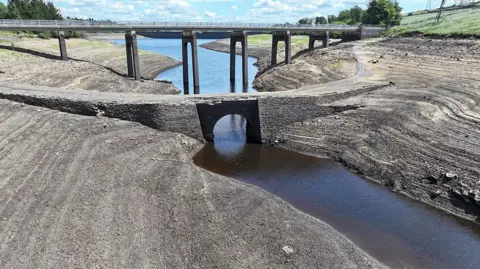More of England likely to be declared in drought
 Getty Images
Getty ImagesMore English regions are expected to join the North West and Yorkshire in an official drought on Tuesday after yet another hot and dry spell of weather.
The announcement is likely to come after the National Drought Group – which manages preparations for dry conditions in England – meets on Tuesday morning.
Declaring a drought means that water companies put in place their plans to manage water resources. That can involve hosepipe bans, but not always.
Droughts are driven by natural weather patterns, but climate change and our growing use of water are raising the risks of water shortages, the Environment Agency says.
The National Drought Group is made up of the Environment Agency, government, Met Office, water companies and others.
There are no official droughts in Wales and Northern Ireland at the moment. Scotland does not declare droughts but monitors "water scarcity".
Parts of eastern Scotland are in "moderate" scarcity – the second most extreme category – which means there is "clear" environmental impact.
In England there is no single definition of drought, but it is ultimately caused by a prolonged period of low rainfall, which has knock-on effects for nature, agriculture and water supplies.
England had its driest spring in more than 100 years, followed by three heatwaves in quick succession for some areas in June and July.
That intense warmth has drawn even more moisture out of the soil.
So while it may be raining where you live today, it's unlikely to be enough to bring water levels back to normal across the country.
The Environment Agency (EA) declares droughts in England based on reservoir levels, river flows and how dry the soil is, alongside long-term weather forecasts.
"We certainly expect more regions to enter drought status," said Richard Thompson, deputy director of water resources at the EA, adding that further details would be announced later on Tuesday.
In a "reasonable worst-case scenario" - where regions get 80% of their long-term average rainfall - another five regions across central and southern England could enter drought status by September, joining Yorkshire and the North West, according to the EA.
Current long-term forecasts suggest roughly normal levels of rainfall over the next few months, however.
If further droughts are declared, it does not automatically mean that hosepipe bans will be put in place, but these can often follow.
Some regions, such as parts of Kent and Sussex, have already declared hosepipe bans, but are not in drought status.
 Getty Images
Getty ImagesThe EA warned last month that England's water supplies could face a shortfall of six billion litres a day by 2055 without dramatic action, driven by rising temperatures, population growth and other factors.
Climate change is expected to lead to drier summers on average, while more intense heatwaves mean more water can be lost via evaporation.

Sign up for our Future Earth newsletter to keep up with the latest climate and environment stories with the BBC's Justin Rowlatt. Outside the UK? Sign up to our international newsletter here.
